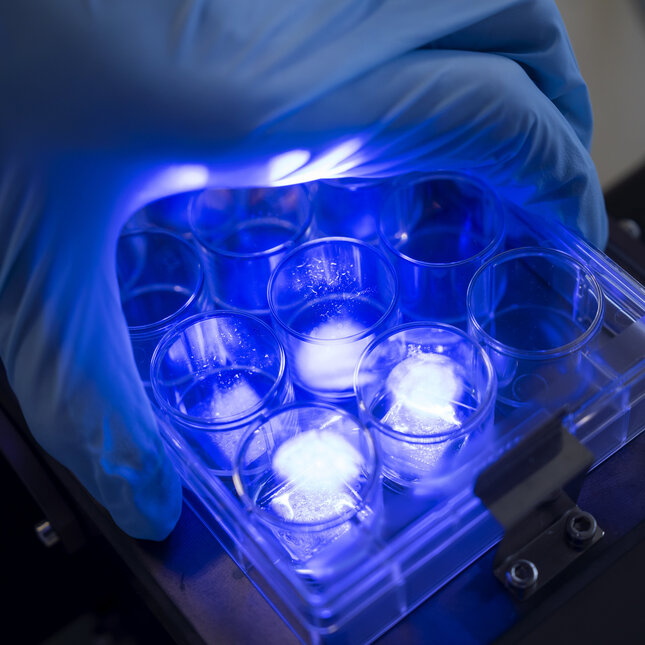Cells in living tissues are constantly exposed to changes. And although many conditions can be replicated in the lab with cultured cells on special gels, the dynamic component was still missing. That is why PhD candidate Maaike Bril developed a hydrogel that can reversibly change shape. By growing skin cells on this innovative hydrogel, she learned more about the chaos and order of scarring. On Wednesday, February 12, she defended her dissertation at the Department of Biomedical Engineering.
Source: Cursor / Nicole Testerink
A small wound can be seen on Maaike Bril's hand. It's from a while ago because there's a scab on it. A fine example of wound healing, she explains with a smile.
"When your skin suffers damage - from a fall, a scrape or a cut - the cells that comprise your skin spring into action. These fibroblasts start producing all kinds of building blocks to close the hole in your skin. Think of the connective tissue proteins collagen and elastin, for example. Activated fibroblasts can develop into myofibroblasts, advanced connective tissue factories. They also help pull the wound edges together, accelerating the healing process."
From chaos to order
Of course, it's great if your wound closes quickly. But when too many myofibroblasts are activated in the body, they produce so many proteins and fibers that it can lead to excessive scar tissue growth. This is commonly known as "proud flesh," a swollen, red scar that can start to proliferate. And you don't want that to happen, Bril stresses.
"We want to have a better understanding of how to move from chaos to order, to eventually be able to control the scarring process. Because such a thickened scar is not only cosmetically undesirable, it can also cause physical symptoms such as pain, itching or loss of function."
During the scarring process, many things change around the skin cells. Therefore, Bril wanted to know how skin cells respond to these changes. But while a great deal can already be replicated in the lab, a method to dynamically change a cell environment was still lacking.
Thanks to the photosensitive hydrogels from the CEC research group Stimuli-responsive Functional Materials & Devices (SFD) that Bril adapted, that method is now a reality, she explains enthusiastically.
Visible groove
"Look." Bril pulls the tag off the tea bag hanging in her glass. "This is the size of the new hydrogels we use to grow skin cells on. But around those few square centimeters, there's a whole setup. So it's still quite a challenge to be able to view your cells under the microscope."
Because it's not just any hydrogel, Bril emphasizes. Under the effect of blue light, the surface of the developed photosensitive hydrogel can change while cells grow on it. With a photomask, you can change the shape into any form you want, she explains.
"In the open areas, the blue light directly hits the gel. There, a transition takes place to a different chemical composition, a hydrophobic one. The water in the gel is then drawn to the parts that are not exposed, and this way, you can create a visible groove in your gel. You can also make it disappear by switching off the light."

Prepared for stress
Researchers from Professor Albert Schenning's SFD group taught her how to make such an innovative photosensitive gel, so for Bril, this was just "a matter of carefully following the recipe." The main challenge for her was adapting the gel to cell culture conditions.
"We're now at the point where we can grow fibroblasts on the adaptable gel and see how these cells respond to changes in their micro-environment. Fibroblasts have hand-like structures that allow them to grasp a surface, and we see that these attachment points shift as we modify the surface. What's remarkable is that cells seem to be able to train themselves to prepare for changes in their environment."
Another notable observation was the moving cell nuclei. Bril: "The moving cell nucleus - where genetic information is stored - shifts to a region of the gel that doesn't change, and it gets smaller at the same time. We think this is how a cell protects its DNA from mechanical stress."
Dynamics
In addition, Bril can deactivate the active myofibroblasts on the adaptable hydrogel to turn them into more passive fibroblasts. This could potentially prevent excessive scar tissue growth.
"What we want to find out now is which proteins are involved in this process so that we can eventually prevent fiber chaos from occurring. This method could hold great potential for tissue regeneration in a broader sense. We're currently working with skin cells as a model system, but in the future, it could also be applied to heart or kidney cells."
Additionally, she hopes to enable real-time monitoring of the cell as it is subjected to changes. "Now, we first need to fix the cells after a light experiment before we can examine them. It may be possible to develop a setup that allows for the hydrogel, photomasks, and lamp to be positioned under the microscope simultaneously. This adaptable gel is truly something new worldwide; we get a lot of enthusiastic feedback about the dynamic aspect. But what would be even more dynamic is if we managed to achieve live-cell imaging with this innovative hydrogel."






